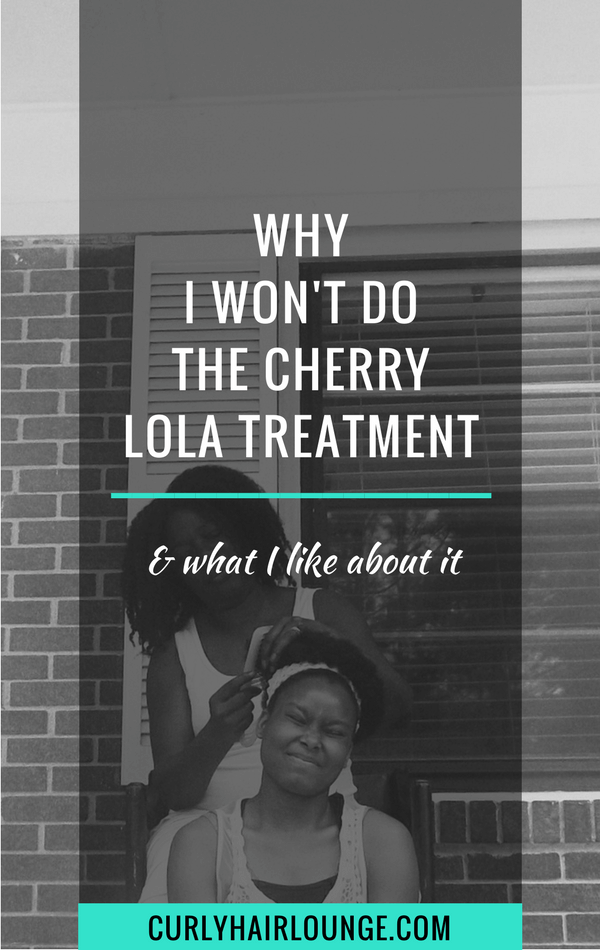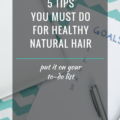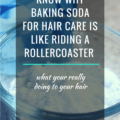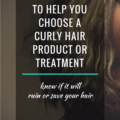Though the name might remind you of some sort of delicious dessert or sweet, the Cherry Lola Treatment is, in fact, a hair treatment whose main benefit is increased hair moisture, especially for those with low porosity hair. Given the dry nature of naturally curly hair and the difficulties many have to keep it moisturised, it’s no wonder this treatment became quite popular in the natural hair community. Still, there is a reason why I won’t do the Cherry Lola Treatment.
The rights to the Cherry Lola Treatment can be attributed to British YouTube blogger Cherry Lola that, just a scientist, named the DIY invention after herself (I guess she anticipated the treatment’s success given its popularity, right?! ‘Cause her name will be forever mentioned in the history of natural hair when it comes to moisture, even if you don’t know who she is. 😉 ).
The treatment’s history dates back to 2009, but in the past years, it seems to be mainly referenced in connection with the Maximum Hydration Method (MHM) – more on this on a future post. In itself, the Cherry Lola DIY concoction is perhaps one of easiest and simplest to make (more than the MHM) as you only need three ingredients – yoghurt, baking soda and liquid amino acids.
What Is The Cherry Lola Treatment
This “deep conditioning” treatment was put together by its creator who accidentally found that it reduced her frizz. With time she also found that it extended her hair moisture, being able to prolonged hairstyles without the need to wash or remoisturize as often. Eureka, I guess!
Today it’s used as a rich protein treatment that deeply boosts your hair with moisture, reduces frizz, prologues hairstyles and supposedly makes your curls tighter (check my DIY protein treatment). What’s not to like, right?! Well… more on that bellow.
How do you mix it?
According to the original recipe, you need to mix 400gr/14oz of organic natural yoghurt with approximately 150ml/10 tbsp. of Bragg’s Liquid Amino acids until you get a brownish cream (mix to a consistency that won’t run through your neck). Next, take 2 1/2 to 3 tbsp. of baking soda and blend it with your mixture. It will become an airy, light cream with air bubbles and it will be ready to use.
How do you apply it?
Thoroughly apply the concoction on clean, dry hair and let it sit for anywhere between 20 to 40 minutes. Once you’re done make sure to rinse well, baking soda if left on the scalp and hair can be disastrous. Follow with a conditioner and style as usual. Here’s Cherry’s video.
It’s actually an easy treatment to make. The benefits can convince anyone to do it – who doesn’t want all that?! Surely, someone crazy. – but, I have to say there’s something I don’t like about it. If you’ve been reading my blog for a while you know me (yeah, your crazy Cherry Lola downer) you know why.
Why I Don’t Like The Cherry Lola Treatment
The reason why I don’t like and will never do this treatment is because of the baking soda. I have talked about the use of this multi-purpose ingredient before, and the risk it poses to my beloved curls is not worth the risk.
I have talked about baking soda extensively in a previous post (Know Why Baking Soda For Hair Care Is Like Riding A Rollercoaster) and I understand why so many love this ingredient as it offers a natural and economic solution to hair care and the results can be amazing. However, the structural damage its use can cause to our curly hair makes me say – Thank you, but no thank you! Still, I’ll give you the run down on it.
The pH case…
The use of baking soda is reportedly said to make natural hair softer, cleaner, healthier, with less frizz and looser curls. However, the use of baking soda raises the pH of hair (4.5 – 5.5) to 9, which alters its acidic environment into an alkaline one.
What does this mean?
The vulnerability case…
It means your scalp and hair are no longer protected from fungi and bacteria (yes, dandruff included). Additionally, the cuticle layers of the hair are forcibly open and your hair is now also vulnerable to dryness, high porosity, split ends, breakage and inability to retain length and moisture. It’s a curly girl’s worst nightmare, you betcha! (check my post on Natural Hair And pH in more detail)
Why it can still work
There are, however, many people who use baking soda and don’t witness these changes in their hair even after years of use. They actually rave about it.
How can this be, after the glooming picture I painted?
Well, scientists put forward many hypotheses, but in a nutshell, it can depend on your hair and scalp’s own pH (it can vary among people), the texture and porosity of your hair (coarser and low porosity hair is more resistant) and your hair’s health.
Why I still won’t do it…
Now, if you ask me – Monica, would you still use baking soda given that you have low porosity hair and it probably won’t suffer any changes? – I would say – Hell, NO!
I wouldn’t risk my natural hair doing the Cherry Lola Treatment or any DIY recipe with baking soda because I can never be sure if my hair and scalp have the set of specific characteristics that would protect them from any possible damage. Even scientist can’t say it yet! Would you risk your hair?
Still, there is something I liked very much about the Cherry Lola deep protein treatment.
What I Like About The Cherry Lola Treatment
Am I leaving you confused? With all these back and forward arguments? I hope not. Just because I don’t like or am very sceptical about this deep conditioning treatment, it doesn’t mean it’s all bad. In fact, I very much like that it has liquid amino acids in it.
Amino acids are basically the smallest part of a protein molecule once it’s broken down into smaller pieces. This means they are so tiny they will easily penetrate the hair shaft to bond with the proteins in the cortex of your hair.
Why it’s so good…
Cherry Lola’s recipe calls for Bragg’s Liquid Amino which is a natural, non-fermented, non-GMO, protein concentrate that has 16 amino acids in it. The good thing about it is that it will strengthen your hair and help moisturise it as proteins delay moisture release, thus why I recommend its (liquid amino) use even for low porosity when so many are afraid to use protein (did you read my post How To Improve Hair Porosity? Go check it out!).
I know many of you reading this post may say that you’re protein sensitive, but amino acids may actually be a good choice for you as they are small enough to penetrate the cuticle layers of the hair to reach the cortex. All hair needs a “protein shot”, simply because it is vulnerable to weather conditions, manipulation, hair tools, water (yes, water too), chemical treatments, free radicals,… the list goes on.
The truth is, you need to replace, strengthen or fortify the “worn down” proteins bonds in your hair so that it can maintain its elasticity (bounce, curl tightness), strength (resilience) and ultimately its health. Lack of protein may slowly, but surely lead you down the road to dryness and hair breakage.
But, there is an even better reason to like this ingredient.
Why it’s even better…
Among Bragg’s impressive list of 16 amino acids, there are a few ones that are instrumental for your hair’s health. These are Alanine, Histidine, Phenylalanine and PCA (derivative of Glutamic acid). A study from 2007, that studied the interactions and effects between hair and amino acids reported its useful use in the hair care industry.
The study found that the use of an aqueous (liquid) solution of amino acids depends largely on the ionic interaction (electrostatic attraction) between amino acids and the hair’s pH. Some will attract better than others at certain pH levels. The tricky thing is to know this.
However, when mixing these amino acids with a conditioner (and I believe a deep conditioner, too) that has cationic (positively charged) surfactants such as behentrimonium chloride, the amino acids will penetrate and bond easily with keratin bonds inside the hair. Some of the benefits are:
- Increased hair moisture
- Increased hair strength
- Improved colour retention for dyed hair (permanent and semi-permanent)
- Thickened hair
- Improves the lipid “glue” that bonds the cuticle layers (+- 14) that protect the hair, especially in the bleached damaged hair. This “glue” is what makes dry and wet hair easier to comb. This is a good tip for those you have bleached hair or are going through a hair transition since damages to the hair cuticle is similar in both chemical treatments.
This is great news, right?
What I Will Do
After all that I’ve said so far, I’m certain I won’t be doing a Cherry Lola Treatment because of the use of baking soda in the recipe. Doing it would basically equate to my hair going on a roller coaster ride on the pH level spectrum and then play Russian roulette hoping my hair won’t come out damaged. I’ll pass this one…
Having said all of this, what I’ll take from the Cherry Lola Treatment is the use of the Bragg’s amino acids and I hope you do too. I will incorporate these into my protein treatments by mixing them with a conditioner or moisturising deep conditioner, maybe mixing a few other things (I can’t help myself, the “mixologist” in me longs to come out! 😉 ) and adding some heat (steam is better) to really kick things up a notch.








28 thoughts on “Why I Won’t Do The Cherry Lola Treatment”
I had a bad experience with baking soda so I’ll never use it on my hair again. It’s not worth the risk to me. But thanks for telling us about Bragg! I’m trying to use a little more protein here and there.
Hey, Del!
Sorry to hear you got a bad experience with baking soda. Some people do love it but, as you experienced it, baking soda is really not worth the risk. Hope your hair is doing better and you got ver the bad experience. By the way, what did you do to recover your hair?
All the best.
Monica
Thanks for this post. I also don’t like baking soda in my hair, so I don’t think I’ll use it again. I just bought Bragg’s Liquid Amino today and I was wondering if I HAVE to add heat to the deep conditioning.
Hey Bri,
No, you don’t HAVE to add heat. However, a deep conditioning treatment will have even better effects on your hair is you add heat to it. You can read this post for some ideas on how you can do that if you ever consider doing it.
Another great article!
Do you have any diy recipes using Bragg’s that you can share?
No, Joe, I don’t have any more recipes using Bragg’s but I’d love to know some more.
Monica
Do you think the treatment would work if you eliminate the baking soda?
Hi, Sharon!
If you take its main ingredient it won’t work the same, but you will still get the benefits of the yoghurt and the liquid amino acids.
Monica
would you do the alternative mix on dry hair?
Olivia, I would apply the mix after my shampoo. This way the cuticle layers of the hair are open and the treatment would penetrate better. I would then rinse and follow with a conditioner to detangle or/and just to remove any lingering smell from the Liquid Aminos. 🙂
Hi, I just came across your blog while researching the cherry lola method. while the videos and results on YouTube wowed me, I was still skeptical about baking soda and I even compared(the softening aspect ) it to perm a little in my mind can u recommend any starting natural hair regimen for a type 4 natural hair/ big chop newbie? if yes, can the amino acids be incorporated into that regimen? thanks for all the info on your blog.
Hi Agie,
To help you develop a hair regimen you can start by reading this 3-part posts series it will be a good start for you. Read all links inside the posts too.
So being that your main concern is the pH rise, wouldn’t an acv rinse help to neutralize the hair? All hair is different, I’ve found with my 3c/4a hair that baking soda is a miracle worker but only in conjunction with a rinse directly after. Or, would that have some other type of negative effect with this treatment?
Yes, theoretically an AVC rinse would lower the high pH of the hair (alkaline) because of the baking soda. However, my point is that the drastic rise and fall in pH damages your hair cuticles and ultimately the hair which can break, increase porosity, loosen its curl pattern… There will always be someone who claims that this treatment works for them and I accept that. Some people will start seeing the negative effects shortly after others only after a long period. A study I read reported that some people’s natural hair pH is higher than most people so they can do a treatment like this and not see their hair pattern change or suffer damages. Still, I don’t want to test my hair on it.
As for AVC being a good thing to use after the Cherry Lola Treatment, I don’t know Ashley. My advice: don’t use baking soda on your hair. Take care.
I tried the treatment and my hair’s texture changed drastically. My hair went from healthy hair to brittle, split-ends, hard, with massive breakage and shedding. It has taken a full year to bounce back. Now, the curls I received immediately after were amazing, but it didn’t last long. I couldn’t pin point what caused the damage. Many thought is was the acv and clay. After reading your post, it very well could have been the soda. Thanks!!
Hi Vicky, it’s tricky dealing with baking soda. Some people claim no effects but these will probably be the people whose hair natural pH is higher than the average person, therefore they can tolerate baking soda better. I rather not risk it. Glad to hear your hair is doing better now!
Hi! Wouldn’t the ACV neutralize the baking soda?
It certainly doesn’t seem to neutralise it, judging by the number of people who claim their hair is damaged after doing this treatment for a while or just by using baking soda. Though not ALL people claim to have this negative effect I wouldn’t risk it. Here is a post I wrote just about baking soda.
Mónica
Plain, full fat yogurt has a ph of around 4. I wonder if that helps balance the baking soda at all?
Hi Me, whether it does or not playing with our hair to find out doesn’t seem like a very good hair care plan. Baking soda can cause real damage to the hair, and there are many people who have lived it. Why risk it? 🙂
Hi Monica! I used the Cherry Cola Treatment ONCE. Will I run the risk of having hair problems in the near future. I do not want to lose my hair. I’ve diligently taken care my hair.
If you didn’t notice any damage to your hair and you never did it again it won’t damage your hair. Keep taking good care of your hair and stay away from this treatment and similar ones.
Hi monica. I find the information very revealing and id like to appreciate you speaking the truth that many sites won’t tell. At least now I know what happened to my hair. I can say that I had the worst experience with the cherry Lola treatment. Pls any help towards recovery for my hair?
Hello, Ify I’m glad you like the information I provide here. Unfortunately, the solutions you have are to cut your damage hair or let your hair grow and gradually cut it until there’s no more damaged hair. Whatever you decide to do make sure you deep condition frequently to help repair your hair. You can read more bout it here and here and you can also get my deep conditioning guide and even more info. Hope this helps.
Hey Mónica, love love your article. I’m a curly girl since 2015 it’s been a struggle but, I’m persevering, when I first seen CLT. I wanted to try it, I was skeptical about it. Do you think I can mix the bentonite clay with the Braggs amino acid? Thanks again for your knowledge!!
Hi Nyah! Though in theory, Braggs has some interesting benefits to the hair I would not make concoctions with it to apply on my hair. I’ve learned this the hard way. The best thing to build a hair routine that is appropriate to your lifestyle and goals and look for well-formulated products that will help you reach your goals and keep your hair healthy. Make sure these products are water-based and give preference to natural ingredients.
When you mix the yogurt (which has a low PH and the amino acid (which also has a low PH with the baking soda (that has a high PH) you end up with a solution that is slightly acidic (below 7 PH) adding a little less baking soda than the recipe calls for will still get the job done.
Hi Tamara, it seems like you have tried the Cherry Lola before. I just don’t advise its practice and there is really no use for it. Curly hair care much easier than doing all of this DIY that doesn’t do good for the hair and scalp.